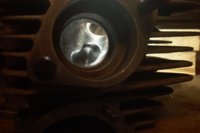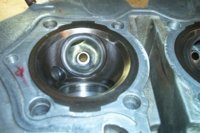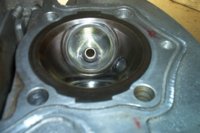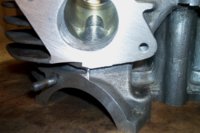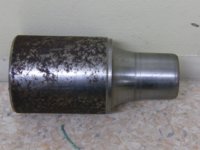been playing with the Dremel. this head is going back on the '73 motor that's getting top end work for the next build. figured i'd document it for possible resale down the road. valves were cleaned up and lapped in thoroughly. i think later i'll build a symmetrical 2 into 1 carb intake for a 36mm VM...
that last time around Jack suggested i cut down the exhaust valve guides. opted not to then but this time i did. it's easy to drill them down with a sharp 5/8 half inch shank drill (low speed with a bit of lube), but you're left with a concave guide end. it's not easy to grind and dress that out manually and would be better to mill the guide off flat...
virtually all the material removed is roof and guide bosses on all ports, without enlarging the IN or EX OD's.
i was considering JBwelding up the intake port floors a couple mm but decided to save that for another more highly modded motor. just to double check- i know i've seen a post or two that says JBweld will safely stick to intakes. if anyone has horror stories about that technique failing please chime in here...
one other concept that crossed my mind while making aluminum dust is that the cavity behind the intake valve guide could be dramatically streamlined if a built up shaped feature was "glued" in. velocity would likely increase but perhaps the turbulence in the intake pocket is more desirable?
pics are of right side IN and EX valves from inside and outside, all inverted.
that last time around Jack suggested i cut down the exhaust valve guides. opted not to then but this time i did. it's easy to drill them down with a sharp 5/8 half inch shank drill (low speed with a bit of lube), but you're left with a concave guide end. it's not easy to grind and dress that out manually and would be better to mill the guide off flat...
virtually all the material removed is roof and guide bosses on all ports, without enlarging the IN or EX OD's.
i was considering JBwelding up the intake port floors a couple mm but decided to save that for another more highly modded motor. just to double check- i know i've seen a post or two that says JBweld will safely stick to intakes. if anyone has horror stories about that technique failing please chime in here...
one other concept that crossed my mind while making aluminum dust is that the cavity behind the intake valve guide could be dramatically streamlined if a built up shaped feature was "glued" in. velocity would likely increase but perhaps the turbulence in the intake pocket is more desirable?
pics are of right side IN and EX valves from inside and outside, all inverted.

